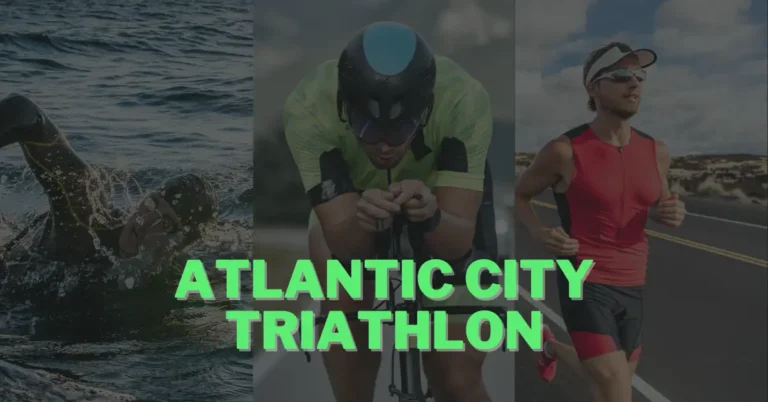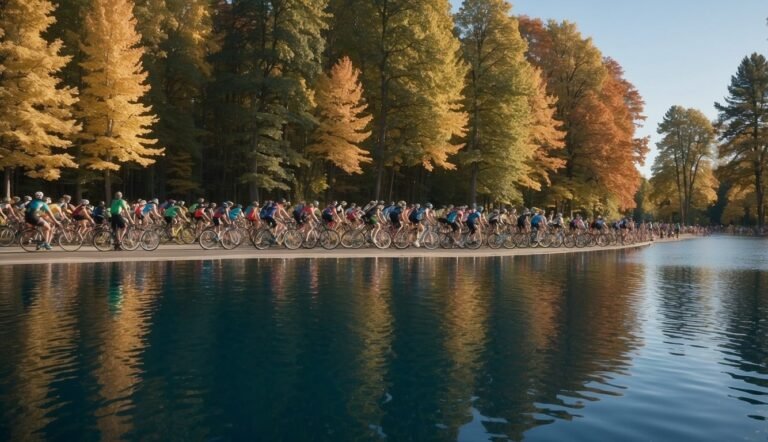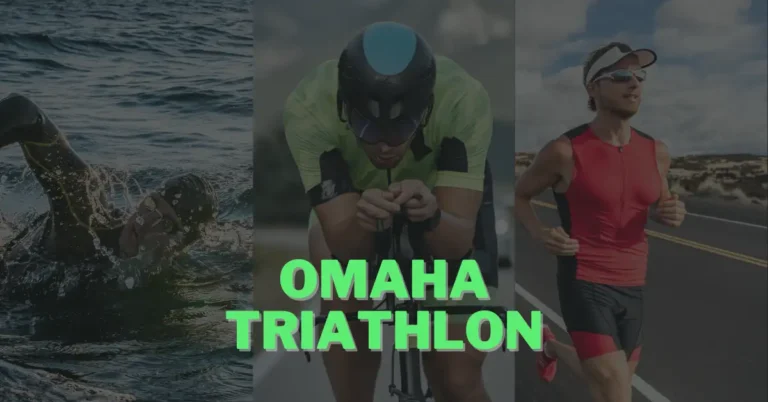📦 FREE Shipping
Mini Triathlon Training 2024: Your Guide to Conquering the Challenge!

Embarking on a mini triathlon training is an exhilarating way to dive into the multisport world. I find that this beginner-friendly event is a fantastic gateway to not only challenge my fitness level but also to experience the camaraderie of the triathlon community. It’s a condensed version of the classic triathlon, yet it retains the essence of the original challenge—swimming, cycling, and running—but with distances tailored to be more accessible to novices like myself.

The appeal of mini triathlons lies in the balanced blend of endurance and speed they require. Committing to this journey has sparked a new sense of dedication in my training routine. Whether I’m in the pool honing my strokes, cycling through the crisp morning air, or pacing myself on a run, each step brings me closer to achieving that profound sense of accomplishment as I cross the finish line.
Being part of a mini triathlon means more than just personal fitness—it’s about joining an inclusive and supportive community. I’ve found that fellow participants and spectators alike contribute to an electrifying atmosphere that propels me forward. It’s not just about the distance; it’s about the shared experiences and the collective triumph over the physical and mental demands of the event.
Getting Started with Mini Triathlon Training
I’m thrilled to dive into the world of mini triathlons, a fantastic entry point into triathlon events for those new to the sport. Mini triathlons offer a blend of swimming, biking, and running, but at distances manageable for beginners.
Understanding the Basics
Mini triathlons, often referred to as sprint or super sprint triathlons, are shorter than traditional Olympic triathlons. These events typically involve:
- Swim: 750m (Sprint) or 400m (Super Sprint)
- Bike: 20km (Sprint) or 10km (Super Sprint)
- Run: 5km (Sprint) or 2.5km (Super Sprint)
I understand that the reduced distances make these races ideal for those looking to test their skills without committing to the intensity of longer distances.
Choosing the Right Distance
When selecting a triathlon, I consider my current fitness level and training time available. A super sprint triathlon is often the best choice for me as a beginner. It allows me to experience all three disciplines without the daunting distances of a standard or Olympic triathlon.
- Super Sprint: An excellent choice for beginners.
- Sprint: Good for those with some experience in endurance events.
I make sure to align my choice with my personal fitness goals and schedule.
Essential Gear and Equipment
To successfully compete in a mini triathlon, I equip myself with essential gear:
- Swim: A comfortable wetsuit for colder waters and goggles.
- Bike: At minimum, a road bike that fits well and is in good working order.
- Run: Quality running shoes that provide support and cushioning.
I consider investing in a triathlon suit for seamless transitions between events. Here’s a quick checklist:
| Discipline | Gear |
|---|---|
| Swim | Wetsuit, Goggles |
| Bike | Road Bike, Helmet |
| Run | Running Shoes |
Ensuring that I have the right gear is essential for both comfort and performance in my mini triathlon experience.
Training for Your First Mini Triathlon

Embarking on my mini triathlon journey, I’ve focused on crafting a robust training plan, bolstering my strength and flexibility, and honing each discipline to ensure I’m as prepared as I can be.
Developing a Solid Training Plan
I started by outlining a training schedule that spans 8 weeks, allocating specific days to running, swimming, and cycling. My week typically looks like this:
- Monday: Rest day to recover.
- Tuesday: 40 minutes of cycling.
- Wednesday: 20 minutes of steady running.
- Thursday: 30 minutes of cycling followed by a 500-yard swim.
- Friday: Rest day to recharge.
- Saturday: 50 minutes on the bike to build endurance.
- Sunday: A combined workout of a 35-minute run and a 400-yard swim session.
Incorporating Strength and Flexibility
I’ve integrated two sessions of strength training into my weekly routine to build the muscle power needed across all three disciplines. Additionally, I make sure to include daily stretching and at least one yoga session per week to maintain flexibility, which is crucial for preventing injuries.
Mastering the Three Disciplines
Getting comfortable in each sport is key. For the swim leg, I make sure to practice in both the pool and open water. Cycling is about consistent effort, focusing on both speed and handling skills. As for the run leg, I mix short sprints with longer, slower runs to build my running endurance. I always transition quickly between disciplines during training to mimic race conditions.

Nutrition and Recovery Strategies
I know just how vital nutrition and recovery are to any triathlete’s regimen, particularly when training for a mini triathlon. Let’s dive right into the specifics of fueling, hydration, and recovery to ensure you’re in top shape for the race.
Fueling for Endurance
To sustain energy during training, carbohydrates are my go-to source. They are pivotal for maintaining high endurance levels. A balanced carbohydrate diet is necessary to fuel both short intense training sessions and long, steady ones. I aim to consume complex carbohydrates such as whole grains, vegetables, and fruits to ensure a steady release of energy.
- Pre-Workout: A meal rich in complex carbs 2-3 hours before training.
- During Training: Small, easy-to-digest carb sources like a banana or energy gel.
Hydration and Electrolyte Balance
Hydration cannot be overstated – it’s essential for my performance and agility on the course. Not just water, mind you, but also electrolytes which help prevent cramping and maintain fluid balance. For electrolyte intakes, I find a sports drink with sodium and potassium does the trick.
- Daily Hydration: Aim for at least 60 oz of water, more if training intensely.
- During Training: An electrolyte-infused beverage every 15-20 minutes.
Post-Training Recovery
Post-exercise recovery is when my body repairs and strengthens. Protein intake in the 30-minute window after training is crucial for muscle repair, while carbohydrates help replenish energy stores. I never skip on a recovery meal or snack that includes both.
- Immediate Recovery Meal: A blend of protein and carbs, like a smoothie with banana, protein powder, and almond milk.
- Ongoing Recovery: Plenty of water, balanced meals, and adequate sleep.
Monitoring and tweaking these strategies help keep my training on track and prepares me to cross the finish line with energy to spare!
Frequently Asked Questions about Mini Triathlon Training
In this section, I’ve gathered the key questions that beginners often ask when considering a mini triathlon. Here’s a quick guide to get you up to speed!
What are the typical distances involved in a mini triathlon?
A mini triathlon typically involves a 400-meter swim, a 10-kilometer bike ride, and a 2.5-kilometer run. This distance may vary slightly, but it’s designed to be achievable for new athletes.
How do I train for my first-ever mini triathlon?
Training for my first mini triathlon involved a balanced approach that increased my endurance in swimming, cycling, and running. I started with shorter distances and gradually increased them, ensuring to include rest days to recover.
What gear do I need to participate in a mini triathlon?
To participate in a mini triathlon, I ensured to have a swimsuit and goggles, a roadworthy bike and helmet, and running shoes. Triathlon-specific clothing that I could wear for all three events was also beneficial.
How soon should I start training for an upcoming mini triathlon?
Ideally, I started training about 12 weeks before the event to build adequate fitness without rushing the process. This timeline allowed me to increase my endurance steadily and avoid injury.
Are there any mini triathlons designed specifically for beginners?
Yes, some mini triathlons are tailored for beginners, offering an inviting and less intimidating atmosphere along with resources such as training plans and tips for first-timers.
What are the different waves in a mini triathlon event like the Chicago Triathlon?
In the Chicago Triathlon, competitors are typically released in waves based on age groups or levels of experience. This helps manage the number of athletes on the course and reduces congestion, making it a smoother experience for all.
Was it interesting to read about the Mini Triathlon Training? Write me a comment. You can read about an Olympic Triathlon Training Plan or USA Triathlon Membership after.





